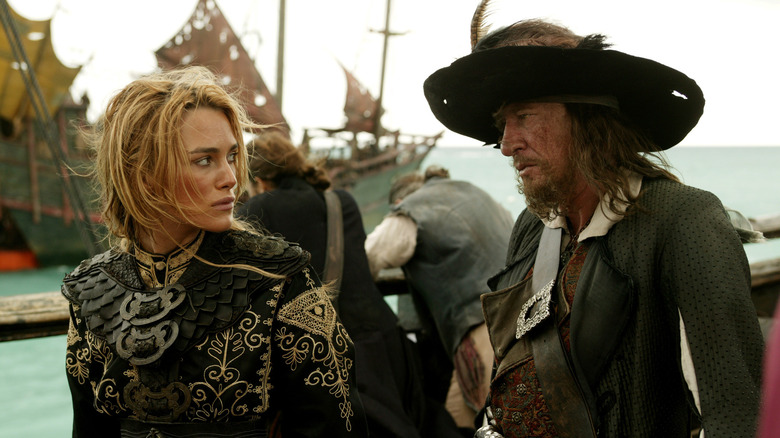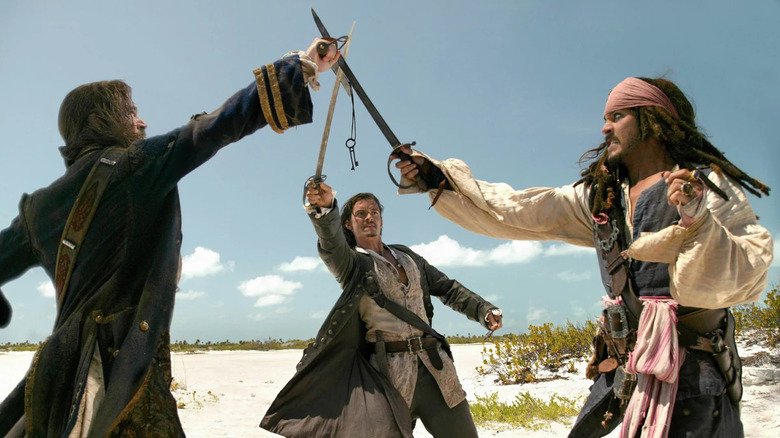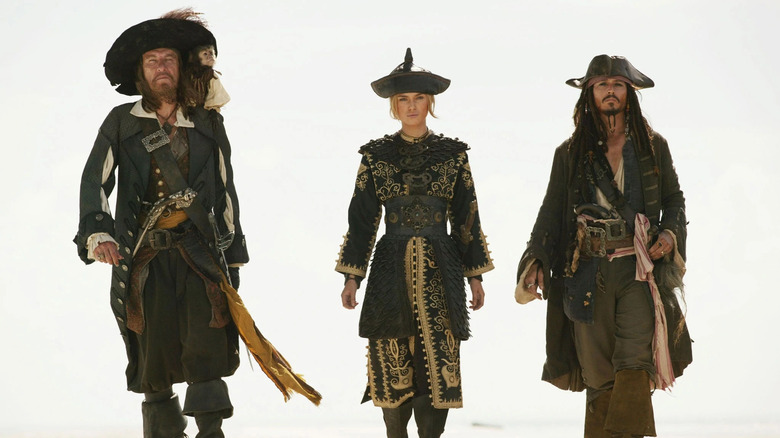Gore Verbinski Was In 'Pure Survival Mode' During Pirates Of The Caribbean 3
Throughout the 2000s, there was a bit of a trend of studios greenlighting multiple movies in a franchise at once and having them filmed back-to-back to avoid any long gaps in releases. "The Lord of the Rings" was the most obvious example, with all three films being made at once and released one year after the other. The first two "Matrix" sequels were also produced back-to-back and were released with only a six-month gap between them. By the time "Revolutions" was released, it was clear that this strategy had diminishing returns: both "Matrix" sequels ended up feeling messy and incomplete. They felt like two halves of a single movie, and as a result neither of them really worked on their own.
The first two sequels of the "Pirates of the Caribbean" franchise were a little bit more successful. They weren't as critically acclaimed as the series' first entry, but they did at least manage to feel like two distinct films, and "At World's End" worked as a far more satisfying conclusion to a trilogy than "Revolutions."
It's surprising that things worked out as well as they did, considering how exhausting the process was for the trilogy's director, Gore Verbinski. Hearing him describe the process in a 2021 interview, it seems like a miracle the movies were even finished at all. "We got hit by a hurricane," he said, "half the set got wiped out. Our tank didn't work. We had to pull stuff back to LA. It was pure survival mode by the time we got to the third [film]."
Verbinski was working on a tight deadline, requiring them to work on both films even though the script for "At World's End" wasn't even finished yet. "Literally, there's no sleep," he said. "Zero."
Two movies at once
Because they were filming two movies at once and time was of the essence, they went through each location with both movies in mind. For a location like the Caribbean island St. Vincent, which is where every scene in Tortuga and Port Royal was filmed, they could only afford to stay there once. As Verbinski explained: "We came to St. Vincent, just shot a few days. And there's one scene that had to be shot for the very end of Pirates 3 five days into 2, not knowing what the script of Pirates 3 was yet."
Despite all the headaches, Verbinski and the crew pulled it off on time. "You just embrace the chaos and figure it out," he said. This mindset ended up being vindicated by the final product. Regardless of what you think of the plot itself, these movies undeniably look beautiful. From the CGI for Davy Jones to the climactic battle within a maelstrom, these movies look even better than most of the action movies coming out today.
The fact that they didn't have the scripts finished before filming is also surprising, considering how smartly written these movies actually are. At least when it comes to tying a bunch of storylines together, "At World's End" in particular is an underrated masterpiece, a movie you'll probably find is far better than you remember. It's a sprawling, conclusive fantasy adventure story where every single character has unique, contrasting motives that evolve in exciting and unexpected directions. It might make for a confusing first watch — critics certainly bashed it for being too convoluted — but you'll be surprised on rewatch just how much every character's actions hold up under scrutiny.
A bit of a miracle
The highlight of the movie is probably the six-way parlay meeting on the island two-thirds of the way through the film, which is layered with an almost absurd amount of subtext behind every line, every action. It's a scene where every single character has their own agenda and most of them are being subtle about it, communicating their thoughts in a way intended for only one or two other people in the scene to understand. Elizabeth tells Will she understands the "burden you bear" (freeing his father), but "I feel that cause is lost." Will responds, "No cause is lost, if there's one fool left to fight for it." It seems like he's talking about himself, but he subtly looks over at Jack.
He's telling her Jack's plan is to stab Davy Jones' heart and become the flying dutchman himself, an action that would both protect Jack's life forever and free Will's father. We see Elizabeth piecing things together while the other characters talk. When she proposes a trade where the pirates hand over Jack in exchange for Will and everyone accepts, it's surprising, but also a development that's perfectly in line with everything we've gotten to know about these six characters throughout the series.
"Dead Man's Chest" and "At World's End" are both filled with moments like these, where it feels like the writers put a ton of thought into what we're seeing. One of the greatest skills an artist can have is making their job look easy, and the crew definitely pulled it off here. Watching tightly written scenes like the one where Will plays the Liar's Dice game or Jack manipulates the pirate lords, you wouldn't be able to tell the movies were filmed in a rush at all.


